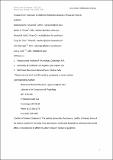A data-driven approach to optimized medication dosing: a focus on heparin
Author(s)
Danziger, John; Richter, Stefan E.; Eche, Ifeoma M.; Chen, Tszyi W.; Ghassemi, Mohammad Mahdi; Celi, Leo Anthony G.; ... Show more Show less
Download134_2014_3406_ReferencePDF.pdf (289.1Kb)
PUBLISHER_POLICY
Publisher Policy
Article is made available in accordance with the publisher's policy and may be subject to US copyright law. Please refer to the publisher's site for terms of use.
Terms of use
Metadata
Show full item recordAbstract
Purpose
To demonstrate a novel method that utilizes retrospective data to develop statistically optimal dosing strategies for medications with sensitive therapeutic windows. We illustrate our approach on intravenous unfractionated heparin, a medication which typically considers only patient weight and is frequently misdosed.
Methods
We identified available clinical features which impact patient response to heparin and extracted 1,511 patients from the multi-parameter intelligent monitoring in intensive care II database which met our inclusion criteria. These were used to develop two multivariate logistic regressions, modeling sub- and supra-therapeutic activated partial thromboplastin time (aPTT) as a function of clinical features. We combined information from these models to estimate an initial heparin dose that would, on a per-patient basis, maximize the probability of a therapeutic aPTT within 4–8 h of the initial infusion. We tested our model’s ability to classifying therapeutic outcomes on a withheld dataset and compared performance to a weight-alone alternative using volume under surface (VUS) (a multiclass version of AUC).
Results
We observed statistically significant associations between sub- and supra-therapeutic aPTT, race, ICU type, gender, heparin dose, age and Sequential Organ Failure Assessment scores with mean validation AUC of 0.78 and 0.79 respectively. Our final model improved outcome classification over the weight-alone alternative, with VUS values of 0.48 vs. 0.42.
Conclusions
This work represents an important step in the secondary use of health data in developing models to optimize drug dosing. The next step would be evaluating whether this approach indeed achieves target aPTT more reliably than the current weight-based heparin dosing in a randomized controlled trial.
Date issued
2014-08Department
Massachusetts Institute of Technology. Institute for Medical Engineering & Science; Massachusetts Institute of Technology. Department of Electrical Engineering and Computer ScienceJournal
Intensive Care Medicine
Publisher
Springer Berlin Heidelberg
Citation
Ghassemi, Mohammad M., Stefan E. Richter, Ifeoma M. Eche, Tszyi W. Chen, John Danziger, and Leo A. Celi. “A Data-Driven Approach to Optimized Medication Dosing: a Focus on Heparin.” Intensive Care Medicine 40, no. 9 (August 5, 2014): 1332–1339.
Version: Author's final manuscript
ISSN
0342-4642
1432-1238